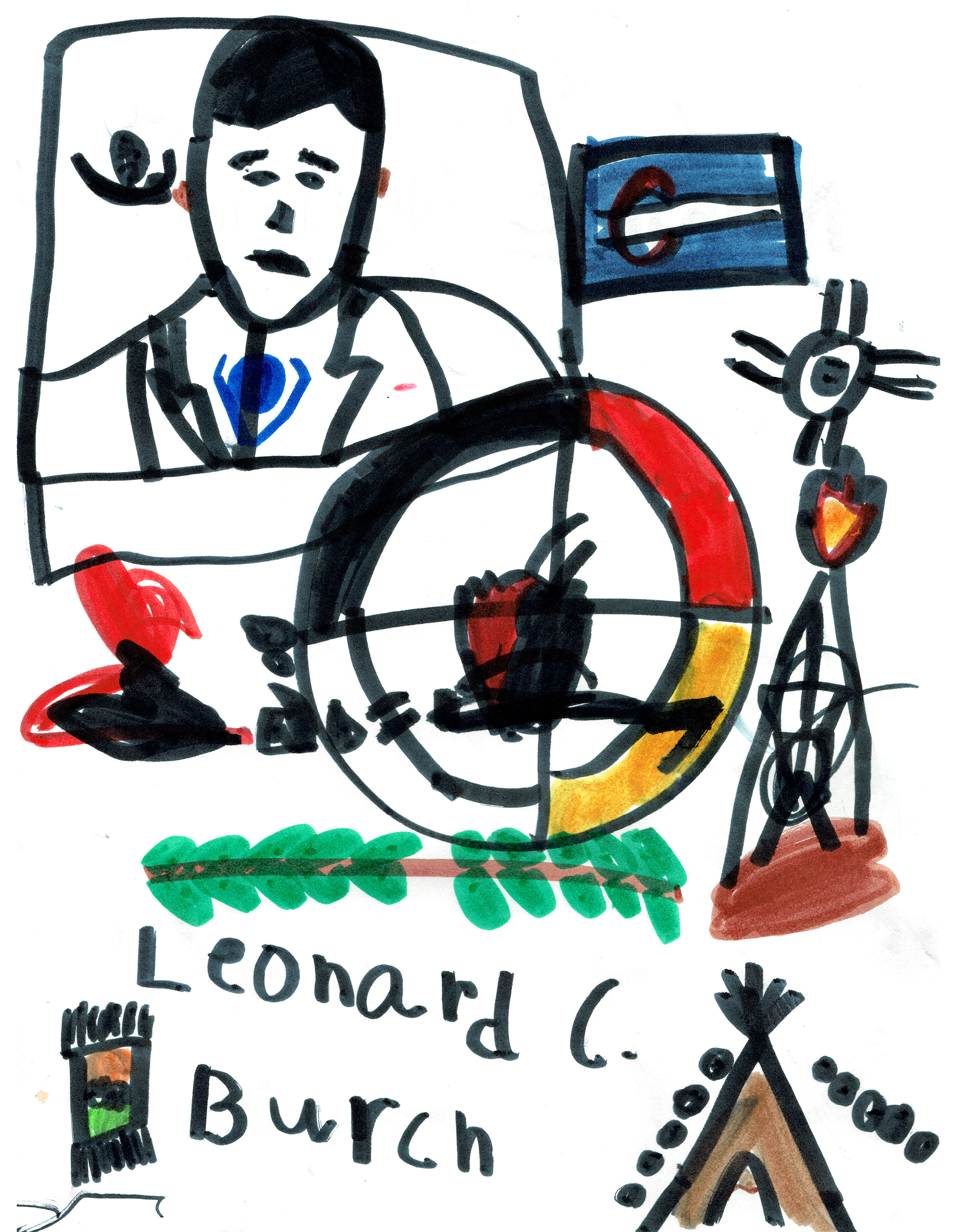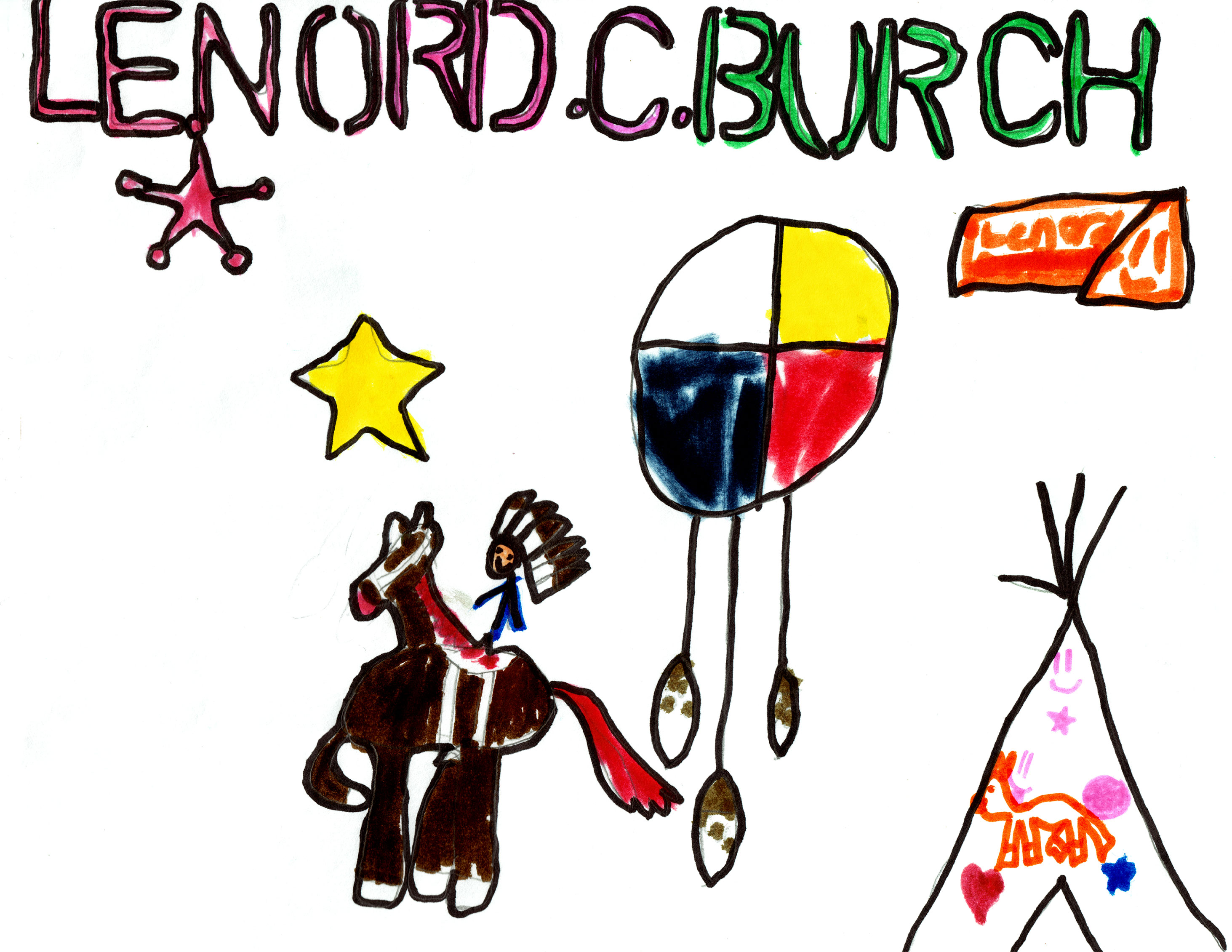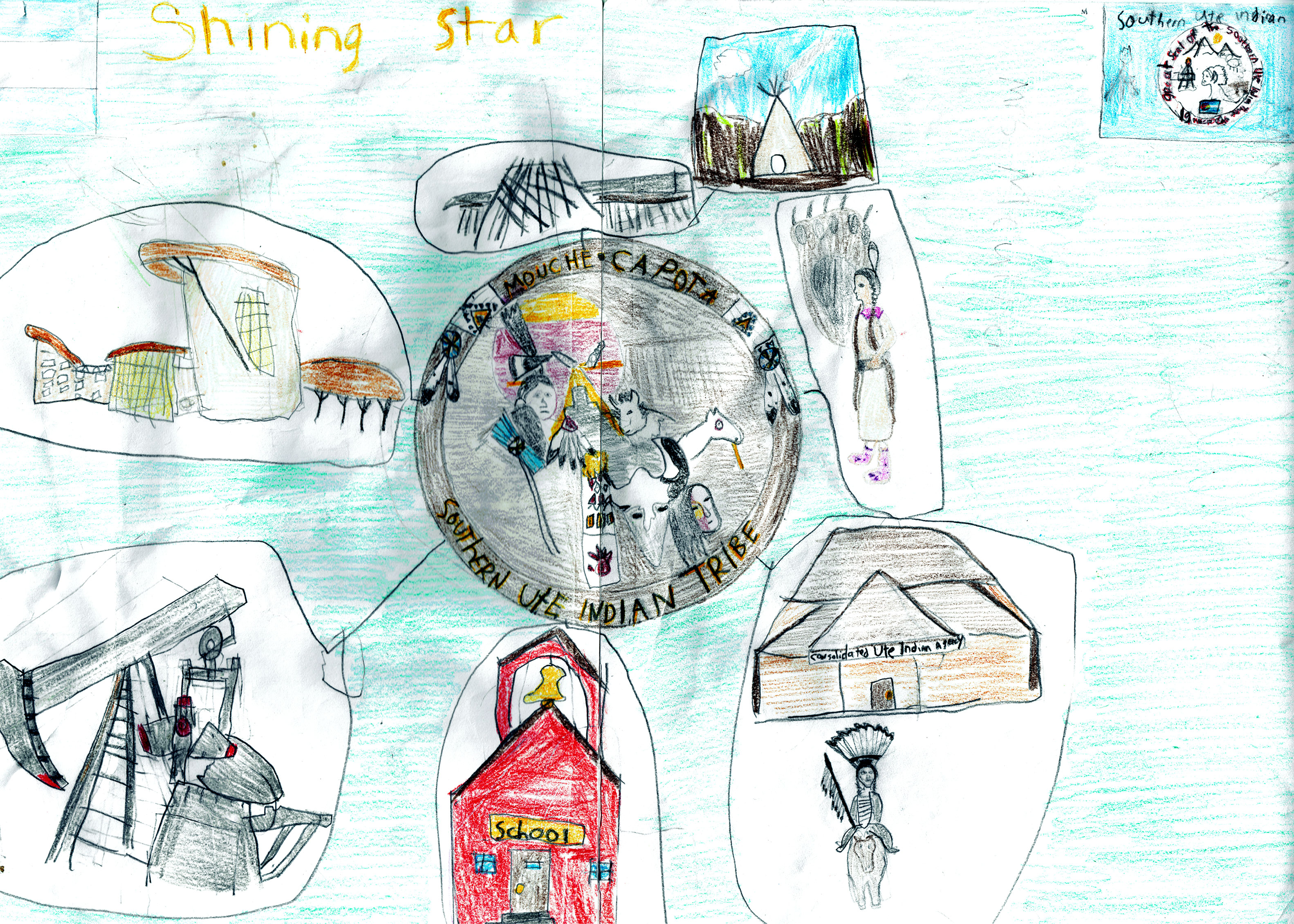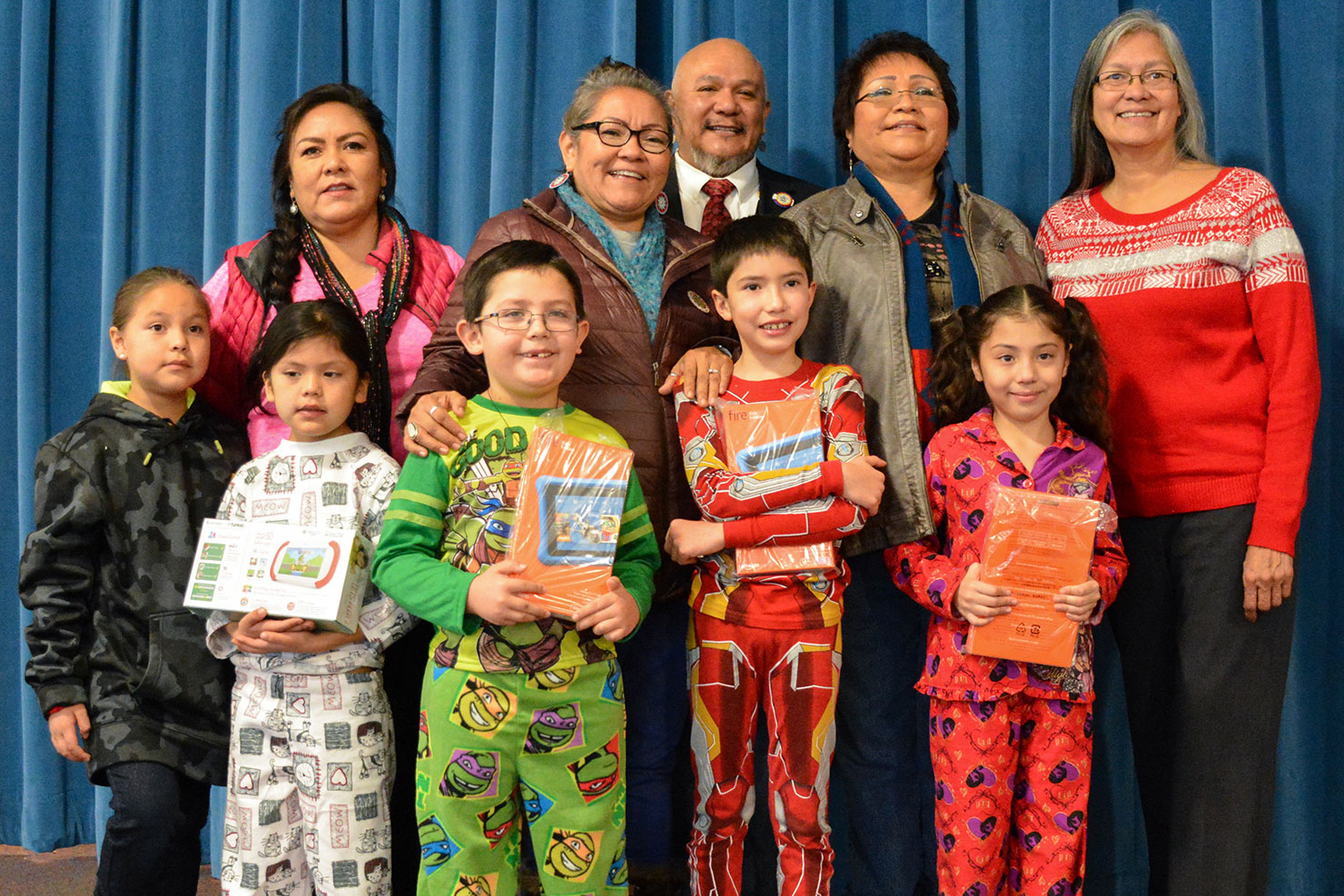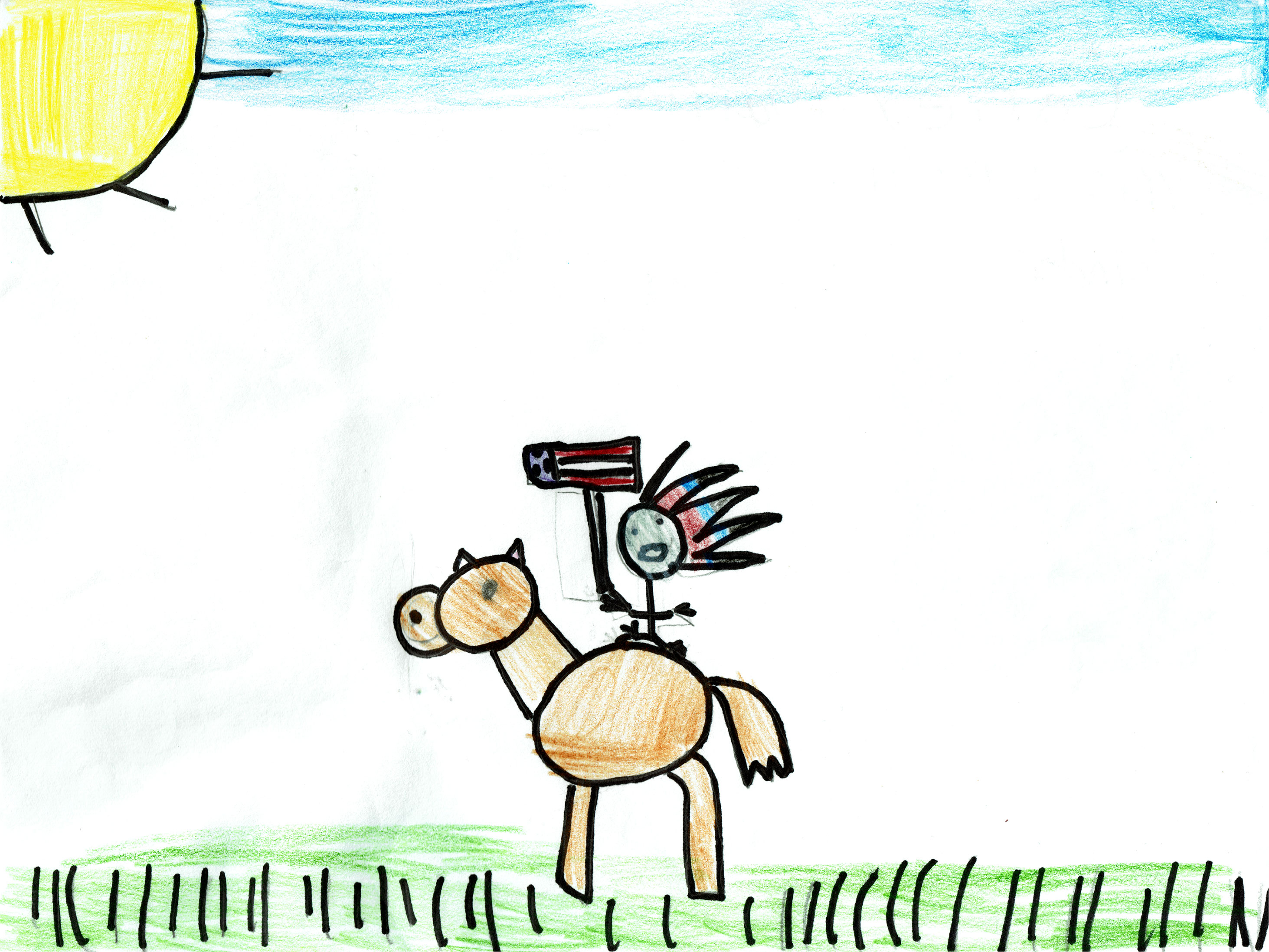LCB Art & Literacy Winners
MIDDLE SCHOOL
- 1st: Demi Hauschild
- 2nd: Karley Pollock
- 3rd: Jackie Carrillo/7th grade
ELEMENTARY SCHOOL
- Kindergarten: Carley Martinez – Mrs. Strohl
- First Grade: Niihdae Neadeau – Ms. Harmon
- Second Grade: Curtis WhiteThunder-Lucero – Mrs. Pearson
- Third Grade: Max Montoya – Mrs. Meunier
- Fourth Grade: Eleahana Martinez – Mrs. Melrose
- Fifth Grade: Elliott Hendren
ELEMENTARY SCHOOL: 4TH GRADE
Pa na poo Cheef
By Eleahana Martinez
Pa na poo Cheef meaning Shining Star.
It comes from the sky.
Which is very far.
So as you see.
It shines upon you.
See how Leonard C. Burch is
And was a good Chairman.
Leonard C. Burch was born in
1933-2003. He was a great leader for a long time of the Southern Ute Tribe.
He died at Mercy Medical Center shortly after
Sunrise in 2003 and he was a Great leader.
Leonard C. Burch went to Washington.
He loved his home and his people.
He helped his people for far into the future.
ELEMENTARY SCHOOL: 5th Grade
Reflection of No Ordinary Man
By Elliott Hendren
Leonard C. Burch was a great man.
No Ordinary Man …
So the stories say …
I wouldn’t know …
He was gone like, the dawn of the first snow …
Gone … Gone … Gone …
His legacy still lives on, through his people,
MY PEOPLE!
He was my uncle, my grandpa’s cousin,
my Grandpas nephew.
He helped bring his people …
My people, into greatness!
His legacy, my legacy …
I will keep his legacy alive!
Because he inspires me, like no ordinary man …
I am called “Shining Star” too …
Like a “Shining Star,” he reflected onto his people.
He took pride in knowing who he was
and where he came from.
He fought for Tribal self-determination.
He served the great United States,
in the Air force …
His country … My country … Our Country …
A leader …
A Veteran …
A Chief amongst men …
He was no ORDINARY MAN.
MIDDLE SCHOOL: 1ST PLACE
LCB & Southern Ute History
By Demi Hauschild
Everybody thinks of something different when they hear the words “Shining Star”. Sceientist would probably think of the starts in space. Movies starts would probably think of themselves and their success. However, here in Ignacio we would think of Leonard C. Burch because his name is literally “Shining Star” (Southern Ute Tribe) in his Native language and culture. He did many wonderful things for his tribe. He was the youngest chariman of the Southern Ute Tribe in history.
There is a vast amount of history to the Southern Ute Tribe. There are many different Ute Bands in the U.S. The two specific bands that form the Southern Ute Tribe are the Mouache and the Caputo Bands. Leonard C. Burch was a part of these two bands. The Mouache Band, before the Europeans came, lived on the eastern side of the Rockies, from Denver to Las Vegas, New Mexico. The Caputo band, before the Europeans, was located east of the Continental Divide near the headwaters of the Rio Grande. They also were populated in the region near Chama and Tierra Amarilla. There were also a few family units that lived “in the shadow of Chimney Rock.” (Southern Ute History). Both bands now are headquartered here in Ignacio. These two bands also participate in two yearly danced. The first dance in the year is the Bear Dance. The Bear Dance is considered a time of rejuvenation. “The Bear awakens from his winter’s sleep and celebrates by dancing to welcome the spring.” (Southern Ute History). The next dance the bands celebrate is the Sun Dance. On the last day of Bear Dance, the Sun Dance Chief announces the dates of the Sun Dance which happens sometime during the summer. (Southern Ute History)
The Southern Ute Tribe speaks a dialect language and their Tribal Seal has symbols with each separate meaning. The Southern Ute Language is Shoshoean, a dialect of the Uto-Aztecan language. There are other tribes that also speak the same dialect and they are the Shoshone, Comanche Chemehuevi, Paiute, Goshute and a few other tribes in California. The Tribal Seal is filled with many different symbols but all the symbols have different meanings. The mountains and forest represent the mountains that are north and on the reservation. The rivers by the mountains and forest represent all the rivers that cross the Southern Ute Reservation. These rivers include the Animas, Florida, La Plata, Navajo, Piedra, Pine and the San Juan. The bear and elk on the seal represent the big game that lives on the reservation. The Sun represents the spirit that watches over people. The tractor, cattle, gas well and sheep represent the farming, ranching and industry that the tribal members and the tribe are involved with to make their living. The Indian head located in the center of the Tribal Seal represents the tribe as a person and a very “colorful man” (Southern Ute Seal and Symbolism) with all of the colors representing the colors of the nature and the colors in the rainbow. The peace pipe represents the Southern Utes as a peaceful people living in peace with their neighbors and coworkers. The two feathers on the peace pipe represent their belief in a Great Spirit and the tribal “Healing Power” as a tribe. (Southern Ute Seal and Symbolism) The leaf and Branch represent their belief in peace which is why it is located by the peace pipe. It also represents the green of the earth and the red of the willows which are used in Sun Dance and Sweat Ceremonies. The Colorado flag represents the state that is the Southern Ute Tribes historical homeland. The red and white circle surrounding the seal represents the “Circle of Life.” Everything within the circle represents the Tribe’s life. (Southern Ute Seal and Symbolism)
This is the history of the Southern Ute Tribe. Leonard C. Burch was an important leader of this tribe. He played a major role in recognizing the potential and developing the tribe’s wealth and energy sources. Now when you hear the words “Shining Star” what do you think?
MIDDLE SCHOOL: 2ND PLACE
Southern Ute Tribe
By Karley Pollock
“As soon as he was over the first hill and out of sight, he stopped. He was just going to peek in the bag. “That could hurt nothing,” he thought. Just as he untied the bag and opened a small slit, they rushed for the opening. They were people. These people yelled and hollered in strange languages of all kinds. He tried to catch them and get them back into the bag. But they ran away in all different directions. From how full the bag was after he had gotten it closed, he could tell there was only a fraction of the what he had started out with. He went to the sacred valley and dumped them out there.
There was a small number of these people. But those few ones were the Utes, the real Utes from around here.” (Southern Ute Tribe) The creation story is one of the many stories shared throughout the Southern Ute Tribe. Leonard C. Burch as was remarkable member of this tribe and has become a crucial part in Southern Ute history.
Leonard C. Burch known as “Shining Star” in his Ute name, he was part of the Mouache and Capote bands that later formed the Southern Ute Tribe. The Mouache band originated on the eastern slope of the Rocky Mountains. They were dispersed from Denver to as far south as Las Vegas, New Mexico. The Capote band lived east of the continental divide by the a Rio Grande river. Both bands participated in the traditional Bear dance and Sun dance. The Bear dance was created when two Ute hunters saw a bear standing on its hind legs facing a tree? The bear was making noise by clawing the tree and dancing. The bear told the young hunter to go back to his tribe and teach them the dance to welcome spring. The Sun dance is the most important dance to the Utes where the dancer engages himself in a quest for spiritual power with the Great Spirit. This is usually comes by a command usually in a dream. These dances both play major roles in the Mouache-Capote bands culture. (Southern Ute Tribe)
Leonard C. Burch also spoke the Ute language which is Shoshonean that comes from the dialect of the Uto-Aztecan language. Many other tribes share this language such as the Paiute, Goshute, Shoshone Bannock, Comanche, and Chemehuevi tribes. The Southern Ute Tribe seal plays a role in the tribe’s history and culture. The mountains and forest on the seal represent the mountains north and on the reservation which is the tribes present homeland. The river represents the many rivers like the Animas and La Plata that cross the reservation. The bear and the elk represent the big game that live on the reservation. The sun shows the spirit that watches over our people. The tractor, cattle, gas well, and sheep represents the ranching, farming and industry that our tribal members and the tribe are involved with to make a living. The Indian head displays the tribe as a person, a very “Colorful Man” with the colors of red, yellow, black, blue and white representing all of the colors of nature. The peace pipe represents the tribe as peaceful people, the two feathers on the pipe represents the tribe’s belief in a Great Spirit and the Tribal “Healing Power” as people. The leaf and the branch represents the tribe’s belief in peace, it also represents the green of the earth and the red willow which is used in the Sundance. The Colorado state flag represents the State of Colorado where the tribes have lived for many years and the circle around the Tribal Seal represents the “Circle of Life” and everything within this circle represents our life. The seal was designed by Ben Watts and Stanley Reed Frost and interpreted by Russel Box Sr. (Southern Ute Tribe)
As you can see, the Southern Ute Tribe is a very unique tribe with many bands joined together. Leonard C. Burch was a part of this tribe and made a big difference in the tribe’s lifestyle. The Southern Ute Tribe continues to share many stories and cultural beliefs and still remains a strong, thriving tribe.
MIDDLE SCHOOL: 3RD PLACE
Shining Star
By Jackie Carrillo
Leonard C. Burch was a loving, compassionate, advocate who will be remembered for his tireless efforts to stand up for the peaceful Southern Ute Tribe and the people. Mr. Burch was part of the Mouache and Capote Band that are still here today in beautiful Ignacio, Colorado. Out of the many bands throughout the whole United States, the Mouache Capote Band is a very unique band
The Mouache Capote Band traveled the vast area of the Great Basin and would set up campgrounds. The early spring or late fall was the time for men to hunt for large animals such as elk, deer, and antelope. Women would trap smaller animals and collect berries and fruits. The Mouache and Capote band also had very important traditional ceremonies that they hold in their loving hearts. One of these amazing traditions includes the Bear Dance. The Bear Dance is a social event to enjoy with other amazing Utes. The Annual Ute Bear Dance is held every spring for everyone to enjoy and be free like the fresh, soft, breeze. The men are in charge to set up the Bear Dance corral. The women are in charge of making the beautiful clothes for the whole family. Another interesting dance that the Utes hold in their warm hearts is the traditional Sundance. The Sundance is an important spiritual ceremony for the Utes and their tradition. This dance is held once a year in the middle of the summer and is important for the Utes on a personal and spiritual level. It is a crucial dance that is a special feature to their tribe and community.
The Utes language is Shoshonean and is believed that people who speak this language are split apart from the other different Uto-Aztecan speaking tribes. Shoshonean is a one of a kind Ute language. Other tribes who speak this language are Goshute, Shoshone, Paiute, and many others. The Utes also had an interesting seal. The Southern Ute Great Seal was created by two artistic Utes, Mr. Russell Box Sr. and Mr. Ben Watts. They created the sea, with meaningful symbols from the Utes unique tribe. Very little tribes use symbols for their seals, which is why the seal is noteworthy. In the center of the seal is a Ute Chief or also known as the “Colorful Man” who represents the whole colorful tribe. Surrounding the Ute Chief are other symbols that are important to many beloved Utes. In fact, the whole seal represents the “Circle of Life” and is now seen as the facet of life for Southern Ute Indians. This seal is an important unit for all Utes. Obviously, the Mouache-Capote Band is a very interesting and amazing tribe.
Leonard C. Burch was a hero to all Indians. Born on December 24, 1933, in Ignacio, Colorado, Leonard Burch, known as Shining Star, was an amazing husband, father, and leader. He stood up in order for his beloved people to stopstruggling and come out strong. Leonard made a path for Indians all over the country and made a successful future for his tribe and people. He gave Utes the most powerful thing…hope. His work shall be remembered by all Utes for he teamed up with 24 other Indian leaders and started the “Council of Energy Resources Tribes” to stop energy companies that were taking natural gas on the Utes land. In result, the’ Council successfully took control of the tribal energy resources. With this, he created the Red Willow Production Company. Red Willow today has become one of the largest natural gas providers in the region. Thanks to beloved Burch, the tribe today has improved and no longer struggles. His people chose him to be the tribe’s youngest chairman in history and he took great care of his tribe and people. Even though Burch was a hard worker he also was a firm believer in traditional tribal ceremonies. He wanted his tribe to remember the Ute ways with compassion. Focusing on his tribe and dream isn’t the only thing he did. He also made time for his beautiful family that he started. After graduating Ute Vocational School in 1954, he served four tours of duty with the U.S. Air Force in Turkey, after he did this he worked for the Bureau of Indian Affairs. Once he got back home he married his love of his life, Irene. Together they had seven gorgeous daughters and they had fourteen amazing grandchildren. Although, Leonard took a stand and was taking time to save his amiable people, he also spent quality time with his sympathetic family. He is my role-model and reminds me of my mother who deeply cares for me. Leonard was also a reliable leader and father. It was his goal to be a great leader and lead everyone he deeply cared for to success.
In the final analysis, Leonard C. Burch was an affectionate, ambitious, considerate, diligent, gregarious, inventive, and sincere man. The list could go on and on. Everyone will remember his efforts to make the Southern Ute tribe and his family the best. He was a great leader and he was a proud man who made a difference. This one man helped create something that shall forever be remembered.

